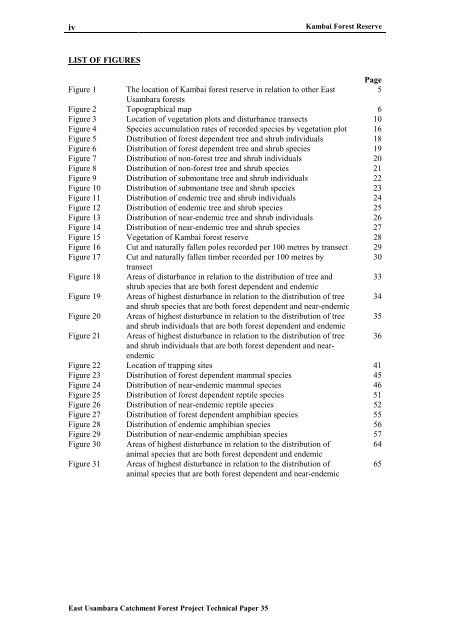East Usambara Catchment Forest Project Technical Paper 35 ...
East Usambara Catchment Forest Project Technical Paper 35 ...
East Usambara Catchment Forest Project Technical Paper 35 ...
You also want an ePaper? Increase the reach of your titles
YUMPU automatically turns print PDFs into web optimized ePapers that Google loves.
iv<br />
Kambai <strong>Forest</strong> Reserve<br />
LIST OF FIGURES<br />
Page<br />
Figure 1 The location of Kambai forest reserve in relation to other <strong>East</strong><br />
5<br />
<strong>Usambara</strong> forests<br />
Figure 2 Topographical map 6<br />
Figure 3 Location of vegetation plots and disturbance transects 10<br />
Figure 4 Species accumulation rates of recorded species by vegetation plot 16<br />
Figure 5 Distribution of forest dependent tree and shrub individuals 18<br />
Figure 6 Distribution of forest dependent tree and shrub species 19<br />
Figure 7 Distribution of non-forest tree and shrub individuals 20<br />
Figure 8 Distribution of non-forest tree and shrub species 21<br />
Figure 9 Distribution of submontane tree and shrub individuals 22<br />
Figure 10 Distribution of submontane tree and shrub species 23<br />
Figure 11 Distribution of endemic tree and shrub individuals 24<br />
Figure 12 Distribution of endemic tree and shrub species 25<br />
Figure 13 Distribution of near-endemic tree and shrub individuals 26<br />
Figure 14 Distribution of near-endemic tree and shrub species 27<br />
Figure 15 Vegetation of Kambai forest reserve 28<br />
Figure 16 Cut and naturally fallen poles recorded per 100 metres by transect 29<br />
Figure 17 Cut and naturally fallen timber recorded per 100 metres by<br />
30<br />
transect<br />
Figure 18 Areas of disturbance in relation to the distribution of tree and 33<br />
shrub species that are both forest dependent and endemic<br />
Figure 19 Areas of highest disturbance in relation to the distribution of tree 34<br />
and shrub species that are both forest dependent and near-endemic<br />
Figure 20 Areas of highest disturbance in relation to the distribution of tree <strong>35</strong><br />
and shrub individuals that are both forest dependent and endemic<br />
Figure 21 Areas of highest disturbance in relation to the distribution of tree 36<br />
and shrub individuals that are both forest dependent and nearendemic<br />
Figure 22 Location of trapping sites 41<br />
Figure 23 Distribution of forest dependent mammal species 45<br />
Figure 24 Distribution of near-endemic mammal species 46<br />
Figure 25 Distribution of forest dependent reptile species 51<br />
Figure 26 Distribution of near-endemic reptile species 52<br />
Figure 27 Distribution of forest dependent amphibian species 55<br />
Figure 28 Distribution of endemic amphibian species 56<br />
Figure 29 Distribution of near-endemic amphibian species 57<br />
Figure 30 Areas of highest disturbance in relation to the distribution of<br />
64<br />
animal species that are both forest dependent and endemic<br />
Figure 31 Areas of highest disturbance in relation to the distribution of<br />
animal species that are both forest dependent and near-endemic<br />
65<br />
<strong>East</strong> <strong>Usambara</strong> <strong>Catchment</strong> <strong>Forest</strong> <strong>Project</strong> <strong>Technical</strong> <strong>Paper</strong> <strong>35</strong>
















